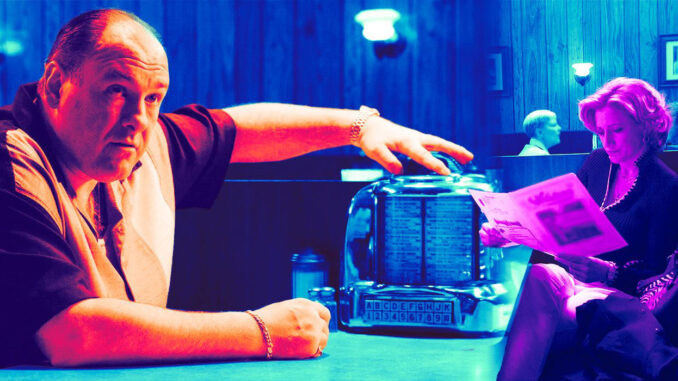
The ending of The Sopranos remains one of the most talked-about moments in television history. The iconic cut to black during the final scene in the diner left fans reeling and speculating about the fate of Tony Soprano. Did he meet his end, or was it just a clever way to signify the closure of his story? Let’s dive deep into the layers of this enigmatic conclusion and explore why it’s much more straightforward than many fans think.
The Tension-Building Diner Scene
When you watch the last scene of The Sopranos, the tension is palpable. David Chase masterfully crafted a moment that feels like it’s teetering on the edge of chaos. As Tony waits for his family in the diner, the atmosphere grows thick with suspense. Each time the door opens with a jingle, the audience is left holding their breath, anticipating who—or what—might enter.
Why Meadow’s Arrival Matters
One of the standout elements of this scene is Meadow’s struggle to park. Her delayed arrival is not just a plot device; it serves to heighten the tension. The camera cuts between Tony’s anxious glances, the other diner patrons, and Meadow’s parking fiasco, building an almost unbearable level of suspense. Fans speculate whether this delay hints at something darker—could it mean Tony’s imminent demise, with Meadow being the last piece of a tragic puzzle?
The “Members Only” Jacket: A Symbol of Threat
Amidst the tension, there’s another layer to consider: the presence of a mysterious man in a “Members Only” jacket. This visual cue has become a focal point for fan theories. With its associations with the mob and the show’s violent undercurrents, viewers can’t help but wonder if this figure represents Tony’s potential assassin. The editing choices in this scene create a sense of looming danger, suggesting that something catastrophic could happen at any moment.
The Cut to Black: More Than Just Ambiguity
The moment the screen cuts to black, viewers are left in stunned silence. This bold choice has sparked endless debate—was Tony killed? Did he escape unscathed? David Chase’s decision to leave the ending open-ended is not merely a gimmick; it serves a deeper narrative purpose.
The Audience’s Experience: An End to the Journey
Chase’s intention seems to be about the audience’s relationship with the world of The Sopranos. The cut to black signals not just the end of Tony’s story, but also the end of the viewer’s journey through this violent, chaotic universe. It’s as if Chase is saying, “You’ve seen enough.” The lives of these characters will continue beyond the screen, regardless of whether Tony lives or dies.
The Significance of POV Shots
The cinematography also plays a crucial role in conveying meaning. Many shots in the diner are framed from Tony’s perspective. When the bell rings and someone walks in, we see Tony’s reaction—a silent acknowledgment of threat. But when Meadow finally enters, instead of cutting to her, the screen abruptly goes black. This choice implies that the viewer is sharing Tony’s final moment, leaving us in the dark about his fate. It’s a masterclass in film language that reflects the unpredictability of life itself.
Thematic Depth: Blood and Cycle
One of the most significant themes throughout The Sopranos is the cycle of violence and depravity. By ending the series with a cut to black, Chase emphasizes that this cycle continues unabated, even after the show concludes. The world Tony inhabits is filled with greed, violence, and familial loyalty—qualities that persist long after the final credits roll.
Tony’s Lack of Transformation
Unlike characters in other shows, such as Walter White in Breaking Bad, Tony doesn’t experience significant transformation. His journey is marked by stagnation, reflecting the cyclical nature of his life. Fans might have hoped for a moment of redemption, but that was never in the cards. The show continuously hinted at the fact that Tony’s path was set in blood and violence.
A Mirror to Reality
The ambiguity of Tony’s fate serves as a mirror to real life. Not everything concludes with a neat bow. Life is messy, and sometimes it feels like a cliffhanger—especially when it comes to the fates of those caught in cycles of violence and crime. Chase invites us to consider this unsettling reality, reminding viewers that the stories we engage with don’t always have clear resolutions.
The Legacy of the Ending
So, is the ending of The Sopranos great because it cuts to black? Absolutely. This choice has left a lasting impression on pop culture and television storytelling. It prompts endless discussions and analyses, keeping the spirit of the show alive long after its conclusion.
A Conversation Starter
The lasting impact of the finale is undeniable. Whether you believe Tony was killed or simply continued his life, the ending allows for rich discussions. Fans dissect the scene, revisit theories, and even create new interpretations years later. The debate around this ending showcases how a narrative can transcend its original context, becoming a cultural phenomenon.
Conclusion
The ending of The Sopranos is a brilliant culmination of the themes and storytelling techniques David Chase employed throughout the series. It’s not merely about Tony Soprano’s fate; it’s a commentary on the cyclical nature of life, violence, and family. The cut to black is a bold choice that resonates with viewers, inviting them to ponder the complexities of morality and the human experience. In a world where narratives often feel predictable, Chase’s decision to leave the conclusion open-ended is both refreshing and thought-provoking.
